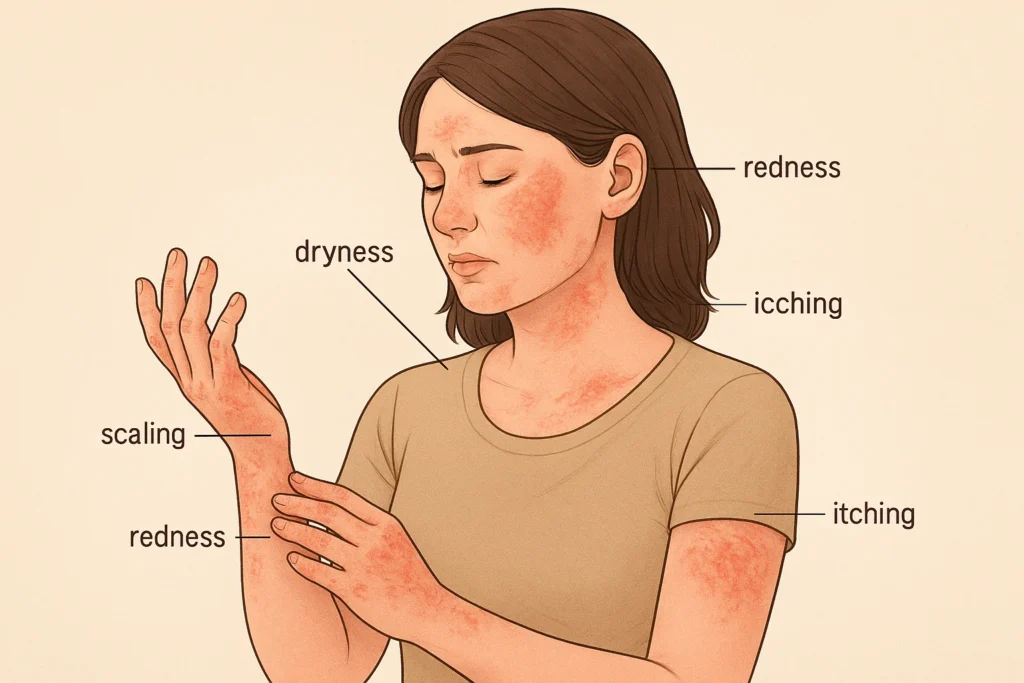Women’s skin is unique, influenced by hormones, genetics, lifestyle, and environmental factors. From acne that flares around menstruation to pigmentation changes during pregnancy, many skin conditions appear differently in women than in men. Some are cosmetic, while others may signal underlying health concerns.
This guide explores the most common skin conditions in women, their causes, symptoms, treatment options, and prevention strategies. Each section links to a detailed article in the Women’s Skin Health Series.
Hormonal and Pigmentation Conditions
Acne Vulgaris in Women: Causes, Symptoms, and Treatment Options
Acne is one of the most common skin complaints in women, often triggered by hormonal changes during puberty, menstruation, pregnancy, or menopause. It usually affects the jawline, chin, and cheeks, and may cause scarring if untreated.
Learn about causes, triggers, and treatment options for acne in women.
Melasma in Women: Understanding the “Mask of Pregnancy”

Melasma leads to brown or gray-brown patches, particularly on the face. It is commonly triggered by pregnancy, oral contraceptives, or sun exposure. Women are far more likely to develop melasma than men.
Discover treatment approaches and prevention strategies, especially during pregnancy.
Female Pattern Hair Loss: Causes and Solutions for Women
Gradual thinning of hair at the crown of the scalp is common among women, especially after menopause. Unlike male baldness, it rarely causes complete hair loss.
Explore available treatments, therapies, and supportive care.
Telogen Effluvium in Women: Postpartum and Stress-Related Hair Loss
Many women experience significant hair shedding after childbirth, illness, or high stress. Although temporary, it can be distressing.
Find out why it occurs and how to support healthy hair regrowth.
Chronic Skin Conditions
Eczema and Dermatitis in Women: Triggers, Relief, and Prevention
Eczema causes dry, itchy, inflamed skin. Triggers include stress, allergies, and hormonal shifts. For women balancing multiple responsibilities, flare-ups can be especially disruptive.
Read about common triggers, skincare routines, and treatment approaches.
Psoriasis in Women: Managing Symptoms and Flare-Ups
Psoriasis is an autoimmune disorder that produces red, scaly patches on the skin. Hormonal changes and stress can worsen flare-ups in women.
Learn about therapies, lifestyle adjustments, and coping strategies.
Rosacea in Women: Redness, Triggers, and Treatment
Rosacea often appears as persistent redness and visible blood vessels on the face, with flare-ups triggered by heat, alcohol, or stress. It is most common in women between 30 and 50.
Understand the causes and explore treatment methods.
Vitiligo in Women: Causes, Coping, and Treatment Advances
Vitiligo causes loss of skin pigment, creating white patches. While it can affect anyone, women often report greater social and emotional impact.
Explore treatment options and coping strategies.
Infections and Genital Skin Conditions
Fungal Infections in Women: Skin Folds, Candidiasis, and Prevention
Moist areas such as the groin, under the breasts, and armpits are prone to fungal infections. Candidiasis is particularly common in women.
Learn how to prevent, identify, and treat fungal infections.
HPV and Genital Skin Conditions in Women: What You Need to Know
The human papillomavirus (HPV) can cause genital warts and is linked to cervical cancer. Skin changes in the genital area can be distressing but are treatable.
Read about diagnosis, treatment, and prevention.
Herpes Simplex in Women: Symptoms, Treatment, and Recurrence
Herpes simplex virus (HSV) causes painful blisters and sores, usually around the mouth or genital area. Women may experience more frequent recurrences than men.
Learn how to recognize and manage outbreaks.
Autoimmune and Connective Tissue Disorders
Cutaneous Lupus in Women: Signs, Diagnosis, and Management
Cutaneous lupus produces rashes, often on sun-exposed skin. Women are disproportionately affected compared to men.
Understand the warning signs, diagnostic methods, and available treatments.
Scleroderma in Women: Skin Tightening and Treatment Options
Scleroderma causes tightening and thickening of the skin and may also affect internal organs. Most cases occur in women.
Discover treatment approaches and supportive care options.
Supporting Skin Care and Lifestyle Guides
Additional resources provide practical advice for women managing their skin health:
- Safe Makeup Ingredients for Sensitive or Hormone-Influenced Skin
- The Connection Between Sleep and Skin Health.
When to See a Dermatologist
Seek medical attention if you experience:
-
Rapidly spreading or painful rashes
-
Sudden or severe hair loss
-
Unexplained or persistent skin discoloration
-
Recurring infections or sores
-
Skin problems that affect your daily life or confidence
Conclusion
Women’s skin health is influenced by hormones, pregnancy, stress, environmental exposure, and genetics. Many conditions are manageable with appropriate care and treatment.
This guide is part of the Women’s Skin Health Series. Explore the linked articles above to learn more about each condition and practical steps to protect and improve your skin health.









